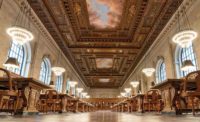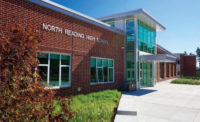Reading Room
“The 9-acre site (including the park) was originally part of Wright Farms, an HOA in unincorporated Adams County at 120th Avenue and Holly Street, annexed by the city of Thornton,” says Dennis Humphries of Humphries Poli of Denver, the project architect. “The site was too narrow for retail, and homeowners opposed commercial development. Significant funds contributed by the community enabled the district to include a park on the site.”
Wright-Farms finished on time and within budget, as did the other three new libraries. The total project cost was $38 million.
“Construction on Wright-Farms began in June 2009 and finished in July 2010,” says Davis. “LEED-Gold certification is all but certain.”
A full service café is currently under construction and will open in the fall.
Anythink Libraries Break With Tradition
Pam Smith, director of the Rangeview Anythink Library District, says that going from one of the poorest library districts in Colorado to being on the leading edge in just two years is pretty close to a revolution.
The district’s 1970s-vintage buildings, some never designed to be libraries, had not been upgraded for decades and were underutilized. Funding from a $38-million bond issue, grants, private funds and donated land allowed the former Adams County Library District, which was established in 1953, to expand from 34,000 sq ft to 110,000 sq ft and reinvent itself.
Planning started at Humphries Poli Architects in 2004, construction began in 2008 and has already produced four new libraries. Two renovations are in progress, and a third is set to begin shortly.
Each of the new libraries is uniquely suited to its site and community, but all share signature features such as locally crafted wood shelving, beetle-kill pine ceilings, photovoltaic or PV-compatible roofs, sustainable design, double-sided fireplaces, indoor-outdoor reading areas, computer labs and automated book tracking. Radio frequency ID tracks circulation via metal strips inserted into books and other materials—the same system used by bookstores.
Community meeting rooms at each library are accessible from the exterior and available after hours.
The award-winning Bennett Library, located for 30 years in a 2,000-sq-ft temporary building intended to last just 10, is the only non-LEED structure among the four new buildings.
“Foregoing LEED saved an estimated $30,000 to $40,000 on commissioning, consultants and paperwork, which paid for the installation of geothermal power,” says Dennis Humphries, Humphries Poli principal.
The 20,000-sq-ft Brighton Library, relocated from a residential neighborhood to a main street, is destined for LEED Gold.
The library is powered by geothermal and a 110-kW rooftop PV array, financed with a grant from the Governor’s Energy Office. Carbon contribution is back-calculated based on energy-use figures from conventional systems.
Brighton Library and the renovated Armory, where National Guard troops once trained, form the city’s new cultural arts center. The two share meeting rooms, parking and intervening open-air spaces designed for community events.
In Northglenn, the 25,000-sq-ft Huron Street Library, a LEED-Silver building, overlooks Niver Creek from a triangular site donated by the city of Thornton. The library it replaced was originally a post office.
Huron offers expansive teens’ and children’s areas, the latter featuring tree houses fashioned from “abstract” bark-covered panels.
Commerce City and Perl Mac (Federal Heights) libraries, both expanding from 7,000 sq ft to approximately 10,000, include geothermal power sources, roofs designed to accept PV installations and community gardens with related educational programming. Scheduled to open by November, the Commerce City site includes a vaulted ceiling with skylights for daylighting. Perl Mac is expected to open by next spring.


